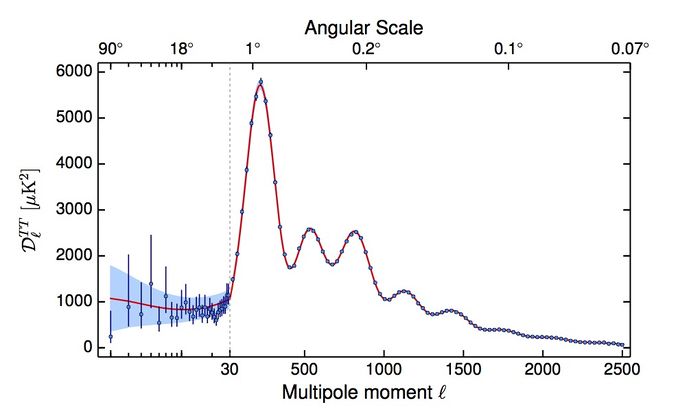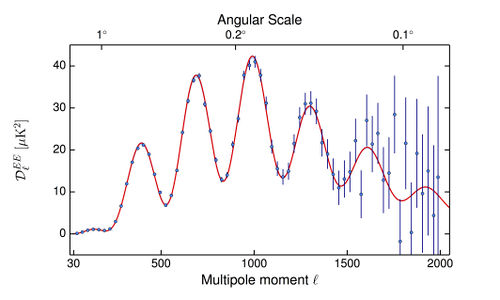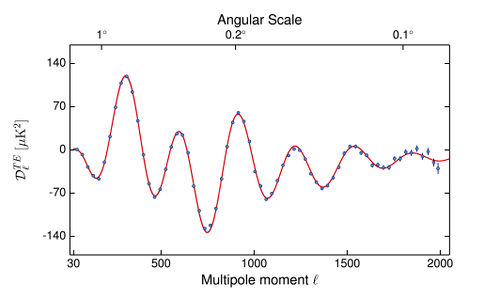Difference between revisions of "CMB spectrum & Likelihood Code"
(→File names and Meta data: fixes) |
|||
| Line 50: | Line 50: | ||
<!--- * ''{{PLASingleFile | fileType=cosmo | name=COM_PowerSpect_CMB_R2.00.fits | link=COM_PowerSpect_CMB_R1.10.fits}}'' ---> | <!--- * ''{{PLASingleFile | fileType=cosmo | name=COM_PowerSpect_CMB_R2.00.fits | link=COM_PowerSpect_CMB_R1.10.fits}}'' ---> | ||
* ''COM_PowerSpect_CMB_R2.nn.fits'' | * ''COM_PowerSpect_CMB_R2.nn.fits'' | ||
| − | which contains 7 extensions | + | which contains 7 ''BINTABLE'' extensions |
| − | ; LOW-ELL ( | + | ; 1. LOW-ELL (TTLOLUNB) |
: with the low ell part of the spectrum, not binned, and for l=2-49. The table columns are | : with the low ell part of the spectrum, not binned, and for l=2-49. The table columns are | ||
# ''ELL'' (integer): multipole number | # ''ELL'' (integer): multipole number | ||
| Line 59: | Line 59: | ||
# ''ERRDOWN'' (float): the downward uncertainty | # ''ERRDOWN'' (float): the downward uncertainty | ||
| − | ; TT BINNED HIGH-ELL ( | + | ; 2. TT BINNED HIGH-ELL (TTHILBIN) |
: with the high-ell part of the spectrum, binned into 83 bins covering <math>\langle l \rangle = 47-2499\ </math> in bins of width <math>l=30</math> (with the exception of the last bin that is smaller). The table columns are as follows: | : with the high-ell part of the spectrum, binned into 83 bins covering <math>\langle l \rangle = 47-2499\ </math> in bins of width <math>l=30</math> (with the exception of the last bin that is smaller). The table columns are as follows: | ||
# ''ELL'' (integer): mean multipole number of bin | # ''ELL'' (integer): mean multipole number of bin | ||
| Line 67: | Line 67: | ||
# ''ERR'' (float): the uncertainty | # ''ERR'' (float): the uncertainty | ||
| − | ; TT UNBINNED HIGH-ELL ( | + | ; 3. TT UNBINNED HIGH-ELL (TTHILUNB) |
: with the high-ell part of the spectrum, unbinned, in 2979 bins covering <math>\langle l \rangle = 30-2508\ </math>. The table columns are as follows: | : with the high-ell part of the spectrum, unbinned, in 2979 bins covering <math>\langle l \rangle = 30-2508\ </math>. The table columns are as follows: | ||
# ''ELL'' (integer): multipole | # ''ELL'' (integer): multipole | ||
| Line 73: | Line 73: | ||
# ''ERR'' (float): the uncertainty | # ''ERR'' (float): the uncertainty | ||
| − | ; TE BINNED HIGH-ELL ( | + | ; 4. TE BINNED HIGH-ELL (TEHILBIN) |
: with the high-ell part of the spectrum, binned into 83 bins covering <math>\langle l \rangle = 47-1988\ </math> in bins of width <math>l=30</math> (with the exception of the last bin that is smaller). The table columns are as follows: | : with the high-ell part of the spectrum, binned into 83 bins covering <math>\langle l \rangle = 47-1988\ </math> in bins of width <math>l=30</math> (with the exception of the last bin that is smaller). The table columns are as follows: | ||
# ''ELL'' (integer): mean multipole number of bin | # ''ELL'' (integer): mean multipole number of bin | ||
| Line 81: | Line 81: | ||
# ''ERR'' (float): the uncertainty | # ''ERR'' (float): the uncertainty | ||
| − | ; TE UNBINNED HIGH-ELL ( | + | ; 5. TE UNBINNED HIGH-ELL (TEHILUNB) |
: with the high-ell part of the spectrum, unbinned, in 2979 bins covering <math>\langle l \rangle = 30-1996\ </math>. The table columns are as follows: | : with the high-ell part of the spectrum, unbinned, in 2979 bins covering <math>\langle l \rangle = 30-1996\ </math>. The table columns are as follows: | ||
# ''ELL'' (integer): multipole | # ''ELL'' (integer): multipole | ||
| Line 87: | Line 87: | ||
# ''ERR'' (float): the uncertainty | # ''ERR'' (float): the uncertainty | ||
| − | ; EE BINNED HIGH-ELL ( | + | ; 6. EE BINNED HIGH-ELL (EELOLBIN) |
: with the high-ell part of the spectrum, binned into 83 bins covering <math>\langle l \rangle = 47-1988\ </math> in bins of width <math>l=30</math> (with the exception of the last bin that is smaller). The table columns are as follows: | : with the high-ell part of the spectrum, binned into 83 bins covering <math>\langle l \rangle = 47-1988\ </math> in bins of width <math>l=30</math> (with the exception of the last bin that is smaller). The table columns are as follows: | ||
# ''ELL'' (integer): mean multipole number of bin | # ''ELL'' (integer): mean multipole number of bin | ||
| Line 95: | Line 95: | ||
# ''ERR'' (float): the uncertainty | # ''ERR'' (float): the uncertainty | ||
| − | ; EE UNBINNED HIGH-ELL ( | + | ; 7. EE UNBINNED HIGH-ELL (EEHILUNB) |
: with the high-ell part of the spectrum, unbinned, in 2979 bins covering <math>\langle l \rangle = 30-1996\ </math>. The table columns are as follows: | : with the high-ell part of the spectrum, unbinned, in 2979 bins covering <math>\langle l \rangle = 30-1996\ </math>. The table columns are as follows: | ||
# ''ELL'' (integer): multipole | # ''ELL'' (integer): multipole | ||
| Line 109: | Line 109: | ||
--> | --> | ||
| + | |||
==Likelihood== | ==Likelihood== | ||
The likelihood will soon be released with an accompanying paper and an Explanatory Supplement update. | The likelihood will soon be released with an accompanying paper and an Explanatory Supplement update. | ||
Revision as of 18:42, 4 February 2015
Contents
[hide]CMB spectra[edit]
General description[edit]
TT[edit]
The Planck best-fit CMB temperature power spectrum, shown in figure below, covers the wide range of multipoles = 2-2508. UPDATE COMMANDER: Over the multipole range = 2–29, the power spectrum is derived from a component-separation algorithm, Commander: applied to maps in the frequency range 30–353 GHz over 91% of the sky Planck-2013-XII[1] . The asymmetric error bars associated to this spectrum are the 68% confidence limits and include the uncertainties due to foreground subtraction.
For multipoles equal or greater than , instead, the spectrum is derived from the Plik likelihood Planck-2015-A11[2] by optimally combining the spectra in the frequency range 100-217 GHz, and correcting them for unresolved foregrounds using the best-fit foreground solution from a Planck TT+lowP CDM run. Associated 1-sigma errors include beam uncertainties. Both Commander and Plik are described in more details in the sections below.

TE and EE[edit]
The Planck best-fit CMB polarization and temperature-polarization cross-correlation power spectra, shown in the figure below, cover the multipole range = 30-1996. The data points relative to the multipole range = 2-29 will be released in a second moment. Analogously to the TT case, the spectrum is derived from the Plik likelihood Planck-2015-A11[2] by optimally combining the spectra in the frequency range 100-217 GHz, and correcting them for unresolved foregrounds using the best-fit foreground solution from a Planck TT,TE,EE+lowP CDM run.
 CMB EE spectrum. The red line is the Planck best-fit primordial power spectrum (cf Planck TT+lowP in Table 3 of Planck-2015-A13[3]). The blue shaded area shows the uncertainties due to cosmic variance alone. |
 CMB TE spectrum. The red line is the Planck best-fit primordial power spectrum (cf Planck TT+lowP in Table 3 of Planck-2015-A13[3]). The blue shaded area shows the uncertainties due to cosmic variance alone. |
Production process[edit]
UPDATE COMMANDER The < 50 part of the Planck TT power spectrum is derived from the Commander approach, which implements Bayesian component separation in pixel space, fitting a parametric model to the data by sampling the posterior distribution for the model parameters Planck-2013-XII[1]. The power spectrum at any multipole is given as the maximum probability point for the posterior distribution, marginalized over the other multipoles, and the error bars are 68% confidence level Planck-2013-XV[4].
The part of the TT, TE and EE power spectra have been derived by the Plik likelihood, a code that implements a pseudo-Cl based technique, extensively described in Sec. 2 and the Appendix of Planck-2013-XV[4] and Planck-2015-A11[2]. Frequency spectra are computed as cross-spectra between half-mission maps. Mask and multipole range choices for each frequency spectrum are summarized in Section 3.3 of Planck-2015-A13[3] and in Planck-2015-A11[2]. The final power spectrum is an optimal combination of the 100, 143, 143x217 and 217 GHz spectra, corrected for the best-fit unresolved foregrounds and inter-frequency calibration factors, as derived from the full likelihood analysis (for TT we use the best-fit solutions for the nuisance parameters from the Planck+TT+lowP data combination, while for TE and EE we use the best fit from Planck+TT+lowP, cf Table 3 of Planck-2015-A13[3]). A thorough description of the models of unresolved foregrounds is given in Planck-2015-A11[2]. The spectrum covariance matrix accounts for cosmic variance and noise contributions, together with beam uncertainties. The CMB TT spectrum and associated covariance matrix are available in two formats:
- Unbinned. TT: 2479 bandpowers (); TE or EE: 1697 bandpowers ().
- Binned, in bins of . TT: 83 bandpowers. TE or EE: 66 bandpowers. We bin the power spectrum with a weight proportional to , so that the binned bandpower centered in is: Equivalently, using the matrix formalism, we can construct the binning matrix B as: where B is a matrix, with the number of bins and the number of unbinned multipoles. Thus: Here, is the vector containing all the binned (unbinned) bandpowers, is the covariance matrix and is the weighted average multipole in each bin. Note that following this definition, can be a non-integer. The binned power spectrum is then calculated as: .
Inputs[edit]
UPDATE COMMANDER
- Low-l spectrum ()
- frequency maps from 30–353 GHz
- common mask Planck-2013-XII[1]
- compact sources catalog
- High-l spectrum ()
- 100, 143, 143x217 and 217 GHz spectra and their covariance matrix (Sec. 3.3 Planck-2015-A13[3])
- best-fit foreground templates and inter-frequency calibration factors (Table 3 of Planck-2015-A13[3])
- Beam transfer function uncertainties Planck-2015-A07[5]
File names and Meta data[edit]
CHECK EXTENSION NAMES
The CMB spectrum and its covariance matrix are distributed in a single FITS file named
- COM_PowerSpect_CMB_R2.nn.fits
which contains 7 BINTABLE extensions
- 1. LOW-ELL (TTLOLUNB)
- with the low ell part of the spectrum, not binned, and for l=2-49. The table columns are
- ELL (integer): multipole number
- D_ELL (float): as described above
- ERRUP (float): the upward uncertainty
- ERRDOWN (float): the downward uncertainty
- 2. TT BINNED HIGH-ELL (TTHILBIN)
- with the high-ell part of the spectrum, binned into 83 bins covering in bins of width (with the exception of the last bin that is smaller). The table columns are as follows:
- ELL (integer): mean multipole number of bin
- L_MIN (integer): lowest multipole of bin
- L_MAX (integer): highest multipole of bin
- D_ELL (float): as described above
- ERR (float): the uncertainty
- 3. TT UNBINNED HIGH-ELL (TTHILUNB)
- with the high-ell part of the spectrum, unbinned, in 2979 bins covering . The table columns are as follows:
- ELL (integer): multipole
- D_ELL (float): as described above
- ERR (float): the uncertainty
- 4. TE BINNED HIGH-ELL (TEHILBIN)
- with the high-ell part of the spectrum, binned into 83 bins covering in bins of width (with the exception of the last bin that is smaller). The table columns are as follows:
- ELL (integer): mean multipole number of bin
- L_MIN (integer): lowest multipole of bin
- L_MAX (integer): highest multipole of bin
- D_ELL (float): as described above
- ERR (float): the uncertainty
- 5. TE UNBINNED HIGH-ELL (TEHILUNB)
- with the high-ell part of the spectrum, unbinned, in 2979 bins covering . The table columns are as follows:
- ELL (integer): multipole
- D_ELL (float): as described above
- ERR (float): the uncertainty
- 6. EE BINNED HIGH-ELL (EELOLBIN)
- with the high-ell part of the spectrum, binned into 83 bins covering in bins of width (with the exception of the last bin that is smaller). The table columns are as follows:
- ELL (integer): mean multipole number of bin
- L_MIN (integer): lowest multipole of bin
- L_MAX (integer): highest multipole of bin
- D_ELL (float): as described above
- ERR (float): the uncertainty
- 7. EE UNBINNED HIGH-ELL (EEHILUNB)
- with the high-ell part of the spectrum, unbinned, in 2979 bins covering . The table columns are as follows:
- ELL (integer): multipole
- D_ELL (float): as described above
- ERR (float): the uncertainty
The spectra give in units of . The covariance matrices of the spectra will be released in a second moment.
Likelihood[edit]
The likelihood will soon be released with an accompanying paper and an Explanatory Supplement update.
References[edit]
- ↑ Jump up to: 1.01.11.2 Planck 2013 results. XI. Component separation, Planck Collaboration, 2014, A&A, 571, A11
- ↑ Jump up to: 2.02.12.22.32.4 Planck 2015 results. XI. CMB power spectra, likelihoods, and robustness of cosmological parameters, Planck Collaboration, 2016, A&A, 594, A11.
- ↑ Jump up to: 3.03.13.23.33.43.53.6 Planck 2015 results. XIII. Cosmological parameters, Planck Collaboration, 2016, A&A, 594, A13.
- ↑ Jump up to: 4.04.1 Planck 2013 results. XV. CMB power spectra and likelihood, Planck Collaboration, 2014, A&A, 571, A15
- Jump up ↑ Planck 2015 results. VII. High Frequency Instrument data processing: Time-ordered information and beam processing, Planck Collaboration, 2016, A&A, 594, A7.
Cosmic Microwave background
Flexible Image Transfer Specification